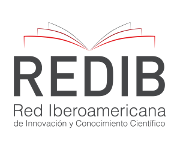Evaluating protection systems against marine corrosion of aeronautic alloy Alclad 2024-T3
Evaluación de diferentes sistemas de protección contra la corrosión marina en la aleación de aplicación aeronáutica Alclad 2024-T3
DOI:
https://doi.org/10.15446/ing.investig.v31n1.20558Keywords:
Alclad 2024-T3, marine corrosion, organic coating, SEM, electrochemical impedance spectroscopy, corrosion. (en)Alclad 2024-T3, corrosión marina, recubrimientos orgánicos, SEM, espectroscopía de impedancia electroquímica, corrosión. (es)
Downloads
This paper shows how two coating systems were obtained as an alternative for protection against corrosion of al clad 2024-T3which is used in battery compartment manufacture for T-41 aircraft. Such systems consist of three types of organic resin: a first layer of P-115 polyester resin as the first coating on both systems, and a second layer of Hetron 197-3 polyester resin in the first system and vinylester resin in the second one. Scanning electron microscopy (SEM) was used for surface morphology analysis, showing the roughness produced by surface treatment. The coatings were electrochemically characterised by electro chemical impedance spectroscopy (EIS) and Tafel polarization curves; it was found that both systems had good performance against corrosion in a marine environment and the chemical surface preparation system had a superior protective pattern for Alodine5700 + 197-3 Hetron, a 1.42x10-12mpy corrosion rate being obtained while substratum rate was 1.59x10-7 mpy.
Se muestra la obtención de dos sistemas de recubrimientos protectores como una alternativa de protección contra la corrosión de la aleación de aluminio Alclad 2024-T3, que es utilizada en la fabricación del compartimiento de la batería de los aviones T-41. Dichos sistemas constan de tres tipos de resinas orgánicas: una primera capa de resina poliéster P-115, a manera de imprimante en ambos sistemas de recubrimientos, y una segunda capa de resina de poliéster Hetron 197-3 en el primer caso, o de resina vinil-éster F-010 en el segundo. El análisis de la morfología superficial se realizó mediante microscopía electrónica de barrido (SEM), observando la rugosidad generada por el tratamiento superficial. El estudio electroquímico de los recubrimientos se desarrolló mediante la técnica de espectroscopía de impedancia electroquímica (EIS) y curvas de polarización Tafel; de esta manera se encontró que todos los sistemas presentan un buen desempeño frente a la corrosión en un medio marino, y que el sistema con preparación superficial química muestra un comportamiento protector superior para el Alodine 5700 + Hetron 197-3; se obtuvo una velocidad de corrosión 1,42 x 10-12 mpy, mientras que para el sustrato la velocidad fue de 1,59 x 10-7 mpy.
Evaluación de diferentes sistemas de protección contra la corrosión marina en la aleación de aplicación aeronáutica Alclad 2024-T3
Evaluating protection systems against marine corrosion of aeronautic alloy Alclad 2024-T3
W. Aperador1, A. F. Escobar2, F. Pérez3
1 Ph.D. en Ingeniería de los materiales, Universidad del Valle. M.Sc. en Metalurgia y Ciencia de los Materiales, Universidad Pedagógica y Tecnológica de Colombia. Vinculado a Ingeniería Mecatrónica, Universidad Militar Nueva Granada, Bogotá. D.C, Colombia. g.ing.materiales@gmail.com
2 Ingeniero de Materiales, Universidad del Valle, Ciudadela Universitaria Meléndez. Escuela de Materiales, Universidad del Valle, Colombia. andresescobar_71@hotmail.com
3Ingeniero de Materiales, Universidad del Valle, Ciudadela Universitaria Meléndez. Escuela de Materiales, Universidad del Valle, Colombia. fapo3000@hotmail.com
RESUMEN
Se muestra la obtención de dos sistemas de recubrimientos protectores como una alternativa de protección contra la corrosión de la aleación de aluminio Alclad 2024-T3, que es utilizada en la fabricación del compartimiento de la batería de los aviones T-41. Dichos sistemas constan de tres tipos de resinas orgánicas: una primera capa de resina poliéster P-115, a manera de imprimante en ambos sistemas de recubrimientos, y una segunda capa de resina de poliéster Hetron 197-3 en el primer caso, o de resina vinil-éster F-010 en el segundo. El análisis de la morfología superficial se realizó mediante microscopía electrónica de barrido (SEM), observando la rugosidad generada por el tratamiento superficial. El estudio electroquímico de los recubrimientos se desarrolló mediante la técnica de espectroscopía de impedancia electroquímica (EIS) y curvas de polarización Tafel; de esta manera se encontró que todos los sistemas presentan un buen desempeño frente a la corrosión en un medio marino, y que el sistema con preparación superficial química muestra un comportamiento protector superior para el Alodine 5700 + Hetron 197-3; se obtuvo una velocidad de corrosión 1,42 x 10-12 mpy, mientras que para el sustrato la velocidad fue de 1,59 x 10-7 mpy.
Palabras claves: Alclad 2024-T3, corrosión marina, recubrimientos orgánicos, SEM, espectroscopía de impedancia electroquímica, corrosión.
ABSTRACT
This paper shows how two coating systems were obtained as an alternative for protection against corrosion of al clad 2024-T3which is used in battery compartment manufacture for T-41 aircraft. Such systems consist of three types of organic resin: a first layer of P-115 polyester resin as the first coating on both systems, and a second layer of Hetron 197-3 polyester resin in the first system and vinylester resin in the second one. Scanning electron microscopy (SEM) was used for surface morphology analysis, showing the roughness produced by surface treatment. The coatings were electrochemically characterised by electro chemical impedance spectroscopy (EIS) and Tafel polarization curves; it was found that both systems had good performance against corrosion in a marine environment and the chemical surface preparation system had a superior protective pattern for Alodine5700 + 197-3 Hetron, a 1.42x10-12 mpycorrosion rate being obtained while substratum rate was 1.59x10-7 mpy.
Keywords: Alclad 2024-T3, marine corrosion, organic coating, SEM, electrochemical impedance spectroscopy, corrosion.
Recibido: noviembre 30 de 2009. Aceptado: enero 24 de 2011
Introducción
Las aleaciones ligeras de aluminio son materiales metálicos de gran aplicación aeronáutica por su alta resistencia mecánica y bajo peso específico. Por ello son empleadas en la construcción del fuselaje y componentes estructurales de las aeronaves, principalmente las aleaciones de la serie 2xxx o duraluminios, siendo la aleación de mayor importancia la AA2024, la cual puede ir chapeada, tratada térmicamente, y es utilizada en toda clase de revestimientos, componentes estructurales y herrajes (Oñate,1991; Hanbook ASM; AirframeHanbook). Sin embargo, las aleaciones de aluminio son susceptibles a corroerse y sufrir ataque destructivo por reacción química o electroquímica con algún medio circundante altamente corrosivo, ambientes marinos y acidificantes. Por consiguiente, y a consecuencia de los problemas generados por disminución de propiedades mecánicas, y sumándole el factor costo que representan medios de inspección, control y mantenimiento, surge la necesidad de desarrollar sistemas de protección contra la corrosión prácticos a nivel industrial, como son los recubrimientos protectores orgánicos, que aíslan la superficie metálica y generan una barrera de impedimento frente a las respectivas reacciones que puedan darse con el medio ambiente presente, para poder contrarrestar y disminuir de esta manera las altas velocidades de corrosión (reporte de la ESTCP; Bierwagen, 2001; Buchheit, 2003; Atta, A. M. y Nassar, 2007).
Los recubrimientos orgánicos a base de resinas sintéticas proveen una excelente protección contra la corrosión siempre y cuando se haya realizado una buena limpieza y preparación de superficie, seguida de un pretratamiento adecuado según del tipo de sustrato a proteger (Atta, A. M. y Elsaeed, 2006; Atta, A. M. y Elsaeed, 2007; Sathiyanarayanan, 2008). Estos sistemas de protección pueden aplicarse en una sola capa o en multicapas, como en el caso de los recubrimientos para la industria aeronáutica, los cuales están constituidos generalmente por un pretratamiento, un imprimante y una pintura de acabado. Diversos trabajos referentes a la innovación y optimización de nuevos recubrimientos alternativos protectores a la corrosión de aplicación aeronáutica han venido desarrollándose (Reynolds, 1997; Z. H. Fang, 2011), investigaciones que se han orientado en dos direcciones: la primera, recubrimientos alternativos a los tratamientos superficiales tradicionales (pretratamiento), siendo los casos más representativos el de los recubrimientos por oxidación química a partir de óxidos de circonio y titanio (Sánchez-Amaya, 2007; Osborne, 2001; Neuder, 2003) y el de los recubrimientos alternativos de los imprimantes orgánicos tradicionales a partir de resinas e imprimantes, sin ninguna incorporación de pigmentos cromatantes como agentes inhibidores a la corrosión (Twite,1998).
El objetivo de este trabajo es el de evaluar y comparar el comportamiento a la corrosión de varios sistemas de recubrimientos protectores alternativos a base de resinas sintéticas, con respecto al utilizado por la industria militar de aviación en sustratos de aleación de aluminio Alclad 2024-T3, mediante la exposición en una solución de 3,5 de NaCl.
Desarrollo experimental
Los revestimientos del fuselaje de las aeronaves T41, al igual que las áreas internas propensas a la corrosión, como es el caso del compartimiento de la batería, están fabricados con láminas de la aleación de aluminio 2024-T3, cuya composición química se muestra en la tabla 1, chapeadas con la aleación 1230, conforme a las especificaciones internacionales de la norma ASTM B209 (tabla 2); y recubrimientos protectores a la corrosión, base pintura, acorde con estándares militares de aviación (pretratamiento superficial, imprimante y pintura de acabado). Dicho sistema de protección está constituido por un tratamiento superficial de nombre comercial Alodine 5700, que genera un recubrimiento de conversión sin cromo, bajo una solución química compuesta de un 80% de un componente inorgánico de especies de oxifluoruro de titanio, circonio y silicio (H2 Ti F6 + Zr O (OH) (CO3)0.5 + SiO2) y 20% de un componente orgánico oly-4-vinyl- fenol y aminas, promoviendo de esta manera un recubrimiento protector inorgánico por conversión a partir de un complejo órgano-metálico de circonatos, y una buena superficie de adhesión para el posterior recubrimiento orgánico; luego, una imprimación superficial con un imprimante epóxico de base cromatante, siendo su principal componente resina epóxica diluida bajo contenidos de cromato de estroncio como pigmentos de protección a la corrosión, y finalmente la pintura de acabado (poliuretano) (Twite,1998).


Los dos sistemas de protección basados en resinas sintéticas constan de las siguientes etapas de aplicación: en el caso del pretratamiento se realizaron dos tipos; el primero fue químico, iniciando con un proceso de limpieza y desengrase con un detergente ácido (a base de ácido fosfórico) a una temperatura de 46 ºC durante 10 minutos; luego se realizó un decapado con NaOH a una concentración de 50 g/l disuelto en agua destilada, durante 1 minuto, a una temperatura de 52 ºC; finalmente, se generó un tratamiento de anclaje con Alodine 5700. El otro sistema fue mecánico, sometiendo las probetas a un proceso de pulido con papel abrasivo de SiC de tamaño 200, y después se hizo el mismo proceso descrito en el tratamiento químico anterior a la aplicación del Alodine 5700.
Para ambos sistemas de preparación se aplicó una delgada capa de resina poliéster Polisec 115, de 50 μm por vaciado, homogeneizando el recubrimiento en toda el área de aplicación. La resina tuvo un tiempo de curado de 20 minutos. Posteriormente se administró a cada uno de los sistemas del pretratamiento una capa de revestimiento compuesto de resina antiácida (resina de poliéster Hetron 197-3 o resina vinil-éster F-010), a la cual se le incorporaron como relleno escamas de vidrio en un 20% (w/w), y 2%(w/w) de catalizador. De esta manera, para los ensayos electroquímicos se efectuó una combinación entre el pretratamiento y la resina poliéster Hetron 197-3, y se denominaron de la siguiente forma: sistema AH1: Alodine 5700 + Hetron 197-3 (1 capa); AH2: Alodine 5700 + Hetron 197-3 (2 capas); H1: pulido mecánico + Hetron 197-3 (1 capa), H2: pulido mecánico + Hetron 197-3 (2 capas). Los sistemas obtenidos para el caso de la resina vinil-éster Vipel F-010, fueron: sistema F1: pulido mecánico + Vipel F010 (1capa), F2: pulido mecánico + Vipel F010 (2 capa); AF1: Alodine 5700 + Vipel F010 (1 capa); sistema AF2: Alodine 5700 + Vipel F010 (2 capas); estos sistemas se compararon con el recubrimiento comúnmente utilizado, el cual es una combinación de Alodine 5700, imprimante epóxico y pintura de poliuretano, recubrimiento que se denominó PIM (figura 1).

Las probetas fueron sometidas a un proceso de limpieza ultrasónica en un baño de acetona y secadas antes del ensayo. Se realizó la medida de espesores usando el medidor Elcometer referencia 300. La caracterización electroquímica se llevó a cabo en un equipo Gamry modelo PCI-4 mediante las técnicas de curvas de polarización Tafel y espectroscopía de impedancia electroquímica, a temperatura ambiente, empleando una celda compuesta por un típico arreglo de 3 electrodos: electrodo de trabajo con un área expuesta de 1 cm2, un electrodo de referencia de Ag/AgCl, y como contraelectrodo un alambre de platino, en una solución de NaCl al 3,5 wt.%. Las mediciones de curvas de polarización Tafel se obtuvieron a una velocidad de barrido de 0,125 mV/s en un rango de voltajes -200 mV hasta + 1200mV vs. Ecorr. Los diagramas de Nyquist se obtuvieron realizando barridos de frecuencia en el rango de 0,001 Hz hasta 100 KHz, empleando una amplitud de la señal sinusoidal de 10 mV. El análisis de composición química de los recubrimientos fue hecha con un microsScopio electrónico de barrido de alta resolución (JEOL JSM - 6490 LV) equipado con un elemento sensitivo de luz (EDX system) y una resoluSción de 1 nm en 30 kV.
Resultados
Morfología y composición química del recubrimiento por conversión Alodine 5700 (SEM y EDS)
El análisis microestructural obtenido por microscopía electrónica de barrido (figura 2), junto con el análisis por EDS utilizado en el análisis químico (tabla 3), confirma la formación del recubrimiento por conversión sobre la superficie del sustrato de Alclad (aleación de aluminio 1230). La morfología superficial observada en SEM (figura 3) ilustra claramente la rugosidad generada por la oxidación química y el EDS registra valores característicos en composición química de elementos como Zr, Ti, Al, F y O, propios del tratamiento con Alodine 5700. La composición de 35% en C verifica la presencia de un ligante orgánico adicional que promueve afinidad química con los recubrimientos orgánicos

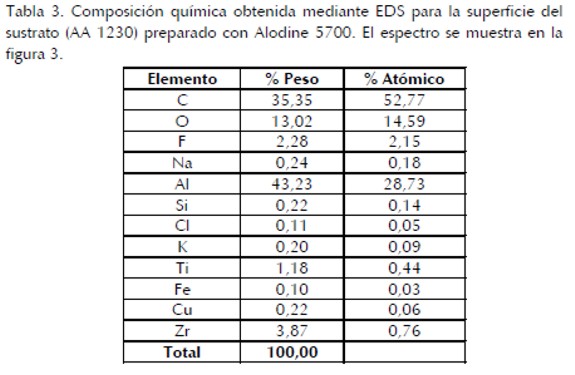

Mediciones de espesores de los recubrimientos orgánicos
De acuerdo a los datos de espesores de capa obtenidos, descritos en la tabla 4, se muestra claramente una diferencia marcada en el espesor entre los recubrimientos aplicados bajo 1 y 2 capas de resina (Hetron 197-3 y Vipel F010).


Los de 1 capa abarcan alrededor de las 200 (μm), mientras que los de 2 capas alrededor de las 300 (μm) de espesor. De este modo se puede observar que, de hecho, el número de capas aplicadas es el único factor que tiene un efecto significativo en el espesor final del recubrimiento, sin importar el tipo de resina ni de pretratamiento.
Las resinas fueron aplicadas de la misma forma, con igual procedimiento, además de que por su naturaleza química tienen densidades específicas y viscosidades comparables entre ellas.
Curvas de polarización Tafel
En la figura 4 se muestran las curvas de polarización Tafel correspondientes a los recubrimientos que se obtuvieron empleando los tres tipos de resina y los diferentes tipos de anclaje utilizados mecánico y químico). Las curvas de polarización obtenidas permiten encontrar los valores de las pendientes anódica y catódica en cada caso, los cuales se muestran en la tabla 4 junto con los valores de densidad de corriente, potencial de corrosión y velocidad de corrosión para cada uno de los casos estudiados.

Los parámetros encontrados con ayuda de las curvas de polarización permiten hacer uso de la ecuación de Stern-Geary (ecuación 1) para hallar las densidades de corriente de corrosión. Se determinó que todos los recubrimientos presentan un buen desempeño debido a que disminuyen el valor de la densidad de corriente en comparación con el sustrato. Los recubrimientos que presentan menor valor de densidad de corrosión son los denominados AH con 1 y 2 capas, seguidos de los utilizados por la industria militar de aviación; los recubrimientos H2 y H1 presentan un comportamiento similar al PIM. Los recubrimientos a los cuales se les realizó un tratamiento de anclaje mecánico con papel abrasivo de tamaño creciente de SiC, tamaño 200, presentan un aumento considerable de la densidad de corrosión en comparación al sistema PIM, esto se debe a que con el pretratamiento de Alodine 5700 se potencializa el efecto pasivante de la superficie del chapeado y se promueve un mejor patrón de adherencia, tanto por la generación de una superficie rugosa, como por la adherencia química debido a la presencia de ligantes orgánicos en el proceso de oxidación química; por otra parte, el proceso mecánico de lijado con papel abrasivo número 200 promueve únicamente una superficie rugosa, y además puede destruir parte de la delgada lámina de chapeado (AA1230), que actúa como un sistema de barrera adicional.
 | (1) |
Los potenciales de corrosión (figura 4) de cada uno de los recubrimientos muestran el estado pasivo de todos los recubrimientos en contraste al sustrato, indicando un buen desempeño frent e a fenómenos de corrosión en este tipo de resinas. La curva de polarización del sustrato muestra un aumento de la densidad de corriente con pequeños incrementos de potencial, generando una disolución general de forma acelerada. Las demás curvas de polarización indican pequeños incrementos de densidad de corriente a medida que se aumenta el potencial, lo que muestra una baja velocidad de corrosión en los recubrimientos evaluados.
La formación de los espectros de impedancia en el diagrama de Nyquist, tanto para la probeta PIM como para AH, H, AF y F, son diagramas conformados por dos semicírculos. Estos sistemas se encuentran representados por un circuito equivalente expuesto en la figura 5.
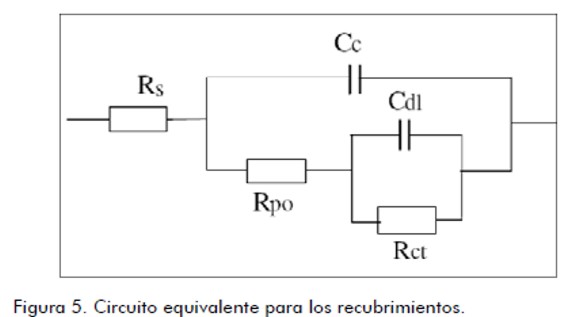
Este circuito equivalente es aplicable para los recubrimientos expuesto a una solución de NaCl 3,5 wt.%. El parámetro de Rs representa la resistencia del electrolito en el caso de los recubrimientos de interés; Cc es la capacitancia de la capa del recubrimiento y Rpo es la resistencia en la interfase soluciónrecubrimiento; en el caso de los sistemas base pintura, hace referencia al recubrimiento conformado por el sistema Alodine 5700, primer epóxico y pintura de acabado, y en el caso de los sistemas base resinas sintéticas AH1 se refiere al sistema conformado por Alodine 5700, imprimante y resina antiácida Hetron197-3, donde el incremento en Cc es una relación directa del nivel de degradación del recubrimiento, mientras que la disminución en Rpo se encuentra relacionada con el incremento en absorción de agua o permeabilidad. El primer semic&ia cute;rculo hace referencia al aporte resistivo de los recubrimientos orgánicos (primer epóxico, pintura poliuretano y resinas sintéticas), puesto que el aporte resistivo de los recubrimiento por conversión son relativamente pequeños, comparado a los recubrimientos orgánicos, y por lo tanto no se registra claramente su aporte de impedancia en el sistema de protección a la corrosión. El recubrimiento con mayor valor de resistencia a la polarización es AH2, el cual se encuentra en el orden de magnitud 1 x 109 kΩ-cm2 y el recubrimiento de la PIM en el orden de magnitud de 1x 08 kΩcm2; los espectros de impedancia obtenidos mediante EIS (figura 6) son correspondientes a los obtenidos con la curvas de polarización Tafel, debido a que los recubrimientos con el tratamiento superficial con Alodine 5700 son los que ofrecen mejores propiedades frente a fenómeno corrosivos. La resina poliéster antiácida Hetron 197-3, a diferencia de la resina Vipel F010, posee una estructura molecular más compacta y densa, resultado de su naturaleza termofija. Debido al entrecruzamiento y reticulación entre cadenas poliméricas por enlaces secundarios, se disminuye el volumen libre de la red polimérica y por ende se reduce la movilidad de especies iónicas del electrolito a través del recubrimiento hasta la interfase sustrato recubrimiento.
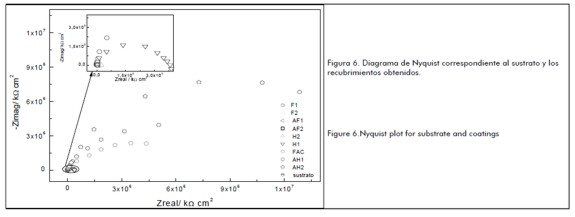
Conclusiones
El pretratamiento en el sustrato chapeado (AA1230) con un recubrimiento por conversión por medio de un proceso de oxidación química genera una mejor resistencia a la corrosión y adherencia con los recubrimientos orgánicos, que un tratamiento superficial mecánico.
Las resinas poliéster Clorendico, de nombre comercial Hetron 197-3, utilizadas como recubrimiento final y barrera, promueven en el sistema de protección mayores mecanismos de protección por barrera química debido a su estructura molecular compacta y densificada, que disminuye la permeabilidad de moléculas de agua y oxígeno, y movilidad de especies iónicas hasta la interfase recubrimiento-sustrato.
El recubrimiento Alodine 5700 + Hetron 197 es superior al sistema implementado (PIM), presentando un valor agregado en cuanto a su relativo menor costo y fácil adquisición en el mercado; por tanto, es de gran interés continuar con el estudio de este tipo de configuraciones en revestimientos de resinas sintéticas.
Referencias
Airframe & Powerplant Mechanics., Airframe Hanbook, U.S Departament of transportation., Federal Aviation Administration.,2008, pp. 45-62.
Atta, A,M., Elsaeed, A,M., Synthesis of unsaturated polyester resins based on rosin acrylic acid adduct for coating applications., Reactive & Functional Polymers, Vol. 67, No. 6, March 30., 2007, pp. 549-563.
Atta, A,M, Elsaeed, A,M, New vinyl ester resins based on rosin for coating applications., Reactive & Functional Polymers, Vol 66 No. 12, June 14., 2006, pp. 1596-1608.
Atta, A, M., Nassar, I.F., Unsaturated polyester resins based on rosin maleic anhydride adduct as corrosion protections of steel., Reactive & Functional Polymers, Vol, 67, No, 7, April, 2007, pp. 617-626
Bierwagen, G.P., Tallman, D.E., Choice and measurement of crucial aircraft coatings system properties., Progress in Organic Coatings, Vol. 41 No. 4, Jan., 2001,pp. 201-216.
Buchheit, R.G., Guan, H., Active corrosion protection and corrosion sensing in chromate-free organic coatings., Fontana Corrosion Center, Progress in Organic Coatings, Vol. 47, No. 4, Oct., 2003, pp. 174-182.
Hanbook ASM., Metallography and Microstructures., ASM international, the materials information society, Vol. 09, 2009, pp.1-109.
Oñate, A. E, Las Aeronaves y sus Materiales. Tecnología Aeronáutica. Edición 1. Paraninfo (Ed), Madrid España., 1991, pp. 123-175.
Osborne, J,H., Testing and evaluation of nonchromated coating systems for aerospace applications., Progress in Organic Coatings, Vol. 41, No. 4, May 15, 2001, pp. 217-225.
Neuder, H., Sizemore, C., Molecular design of in situ phosphatizing coatings (ISPCs) for aerospace primers., Progress in organic coatings, vol. 47, No 3-4, March 4, 2003, pp 307 - 311.
Reporte de la ESTCP., Environmental Security Technology Certification Program., Non-Chromate Aluminum Pretratments, August 2003, Virginia, Oct ., 2004, pp. 1-110.
Reynolds, L.B., Twite, R., Preliminary evaluation of the anticorrosive properties of aircraft coating by electrochemical methods., Progress in Organic Coatings, Vol. 32 No.1-4, April 7, 1997, pp. 31-34.
Sanchez-Amaya, J.M., Osuna, R.M., Monitoring the degradation of a high solids epoxy coating by means of EIS and EN, Progress in Organic Coatings, Vol. 60 No 3, July 31, 2007, pp. 248-254
Sathiyanarayanan, S., Azim, S., Corrosion protection coating containing polyaniline glass flake composite for steel., Electrochemical Acta, Vol. 53 No5, January 1, 2008, pp. 2087- 2094.
Twite, R.L., Bierwagen, G.P., Review of alternatives to chromate for corrosion protection of aluminum aerospace alloys., Progress in organic coatings, Vol. 33, No 2, Feb 23, 1998, pp. 91-100.
Z.H. Fang, H.Y. Duan, Z.H. Zhang, J. Wang, D.Q. Li, Y.X. Huang, J.J. Shang, Liu., Z.Y., Novel heat-resistance UV curable waterborne polyurethane coatings modified by melamine., Applied Surface Science Vol. 257, No. 11, 15 March 2011, pp. 4765-4768.
Evaluating protection systems against marine corrosion of aeronautic alloy Alclad 2024-T3
W. Aperador1, A. F. Escobar2, F. Pérez3
1 Ph.D., in Materials Engineering- Universidad del Valle. M.Sc., in Metallurgy and Materials Science-Universidad Pedagógica y Tecnológica de Colombia. Linked to Mechatronics Engineering Career, Universidad Militar Nueva Granada, Bogotá.D.C, Colombia. g.ing.materiales@gmail.com
2 Materials Engineer, Universidad del Valle, Ciudadela Universitaria Meléndez. School of Materials Universidad del Valle, Colombia. andresescobar_71@hotmail.com
3 Materials Engineer, Universidad del Valle, Ciudadela Universitaria Meléndez. School of Materials Universidad del Valle, Colombia. fapo3000@hotmail.com
ABSTRACT
This paper shows how two coating systems were obtained as an alternative for protection against corrosion of al clad 2024-T3which is used in battery compartment manufacture for T-41 aircraft. Such systems consist of three types of organic resin: a first layer of P-115 polyester resin as the first coating on both systems, and a second layer of Hetron 197-3 polyester resin in the first system and vinylester resin in the second one. Scanning electron microscopy (SEM) was used for surface morphology analysis, showing the roughness produced by surface treatment. The coatings were electrochemically characterised by electro chemical impedance spectroscopy (EIS) and Tafel polarization curves; it was found that both systems had good performance against corrosion in a marine environment and the chemical surface preparation system had a superior protective pattern for Alodine5700 + 197-3 Hetron, a 1.42x10-12mpycorrosion rate being obtained while substratum rate was 1.59x10-7 mpy.
Keywords: Alclad 2024-T3, marine corrosion, organic coating, SEM, electrochemical impedance spectroscopy, corrosion.
Received: November 30th 2009. Accepted: January 24th 2011
Introduction
Lightweight aluminium alloys have many applications in aviation due to their great strength and low specific weight. They are therefore used in constructing aircraft fuselage and structural components, mainly 2xxx series alloys and duralumin, alloy AA2024 having greater importance as it can be plated, heattreated and is used in all kinds of coatings, structural components and fittings [Oñate, 1991; ASM Handbook; Airframe Handbook]. However, aluminium alloys are susceptible to corrosion and suffer destructive attack by chemical or electrochemical reaction in highly corrosive marine and acidifying surroundings. Thus, in addition to the problems arising from decreased mechanical properties and adding costs involved in means of inspection, control and maintenance, systems must be developed which provide practical, industrial-level corrosion protection, such as organic protection coating isolating a metal surface and creating a barrier against reactions which may occur with such environment to counteract and thus reduce high corrosion rates (ESTCP report; Bierwagen, 2001; Buchheit , 2003; Atta A, M and Nassar 2007).
Organic synthetic resin-based coatings provide excellent protection against corrosion, as long as they have been well cleaned and their surface has been prepared, followed by appropriate pre-treatment depending on the type of substrate to be protected (Atta A,M and Elsaeed, 2006; Atta A,M and Elsaeed, 2007; Sathiyanarayanan,2008). Such protection schemes can be applied in a single layer or multilayer, as in the case of coatings for the aerospace industry which generally consist of pretreatment and primary and finishing coats. Several studies related to innovation and optimising new alternative protective coatings against corrosion have been developed for application to aircraft (Reynolds, 1997 and Z.H. Fang, 2011). Research has focused on alternative coatings to traditional surface treatment (pre-treatment), this being the most representative case, and coatings provided by chemical oxidation from zirconium and titanium oxides (Sanchez-Amaya, 2007; Osborne,2001; Neuder, 2003), resins and primers without any incorporation of pigment combatants as corrosion inhibitors (Twite,1998).
The aim of this study was to evaluate and compare the corrosion pattern of several systems for alternative synthetic resin-based protective coatings compared to that used in the military aviation industry in al clad aluminium substrate alloy 2024-T3, by exposure in a 3.5 NaCl solution.
Experimental setup
T41 aircraft fuselage coatings and internal corrosion-prone areas, such as battery compartments, are made of sheet aluminium alloy 2024-T3(chemical composition shown in Table 1),1230- plated alloy, according to American Society for Testing and Materials (ASTM) B209 international specifications (Table 2) and corrosion protection coatings, a paint base according to military aviation standards (surface pre-treatment, primer and finish paint). This protection system consists of a surface treatment (trade name Alodine 5700)producing a chrome-free conversion coating in a chemical solution consisting of an 80% inorganic component including titanium, zirconium and silicon oxy fluoride species (H2 F6 + Zr Ti O (OH) (CO3) 0.5 + SiO2) and 20% organic poly-4-vinyl-phenol and amines, thereby promoting a protective coating by inorganic conversion from an organ-metallic zirconate complex and a good bonding surface for subsequent organic coating. There is also an epoxy chromatin-based surface primer, its main component being epoxy resin diluted as strontium chromate pigments for corrosion protection. A paint finish (polyurethane) is applied on top (Twite,1998).


The two synthetic resin-based protection systems involved the following implementation stages. There were two types in the case of pre-treatment; the first was chemical initiating cleaning and degreasing process with a phosphoric acid-based detergent acid at 46º C for 10 minutes, etching then being made with NaOH at 50 g / l concentration dissolved in distilled water for 1 minute at 52°C and finally anchor treatment (Alodine 5700). The other system was mechanical, specimens being polished with 200 mm SiC aasive paper and then subjected to the same process described in chemical treatment prior to Alodine 5700application.
A thin polyester resin layer (50 micron Poly-sec 115) was applied by casting for both types of preparation; the coating was homogenised over the entire application area. The resin had a 20- minutecuring time. A layer of resin composite coating antacid (197-3 Hetron polyester resin or vinyl ester resin F-010) was then applied to each pre-treatment system incorporated as filler in 20% glass flake (w / w) and 2% (w / w) catalyst ratio. A combination of pre-treatment and Hetron 197-3polyester resin was used for the electrochemical tests and named as follows: AH1 system, Alodine 5700 + Hetron 197-3 (1 layer); AH2, Alodine 5700 + Hetron 197-3 (2 layers); H1, + Hetron 197-3 mechanical polishing (one layer); H2, + Hetron 197-3 mechanical polishing (2 layers). Systems obtained for Vipel F-010vinyl-ester resin were: F1 system, mechanically polished Vipel F010 + (1 layer); F2, F010 Vipel + mechanical polishing (2 layers); AF1,Alodine 5700 + Vipel F010 (1 layer);AF2,VipelAlodine 5700 + F010 (2 layers).These systems were compared to a commonly used coating, which is a combination of Alodine 5700, Epoxy primer and polyurethane paint; this coating was called PIM (Figure 1).
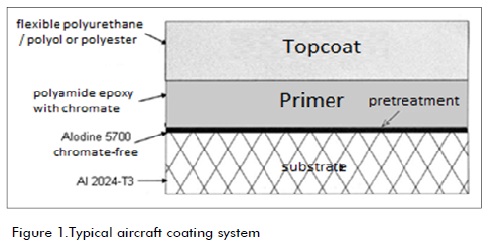
The specimens were subjected to ultrasonic cleaning in an acetone bath and dried before testing. Measurements were taken with an Elcometer300thicknessgauge. Electrochemical characterization was performed on a computer (GamryPCI-4) using Tafel polarization curves and electrochemical impedance spectroscopy at room temperature. A cell consisting of a typical 3-electrode arrangement was used with working electrode having a1 cm2 exposed area, an Ag / Ag Cl reference electrode as counter electrode and a platinum wire in a 3.5% wtNaClsolution.Tafel polarization curve measurements were obtained at 0.125 mV / s scan rate in a -200 mV to +1200 mV voltage range cf open circuit potential (Ecorr). Nyquistplots were obtained by frequency sweeps in the 0.001 Hz to 100 KHzrange using 10 mV sine signal amplitude. The coatings´ chemical composition was analysed by using a high-resolution electron scanning microscope (JEOL JSM - 6490LV) equipped with a light sensitive element (EDX system) at1 nm at 30 kV resolution.
Results
Morphology and chemical composition of Alodine5700 conversion coating (SEM / EDS)
The microstructure obtained by scanning electron microscopy (Figure 2), together with EDS chemical analysis (Table 3), confirmed conversion coating formation on Alclad substrate surface (aluminium alloy 1230). The surface morphology observed by SEM (Figure 3) clearly illustrated the roughness produced by chemical oxidation and the characteristic values recorded EDS chemical composition for elements such as Zr, Ti, Al, F and O, following treatment with Alodine 5700.The 35% composition in C verified the presence of an additional organic binder promoting chemical affinity with the organic coatings applied later on Al1230 plating.
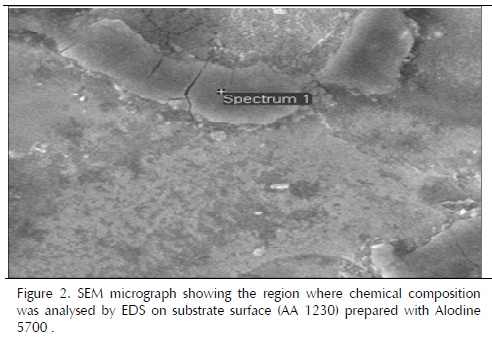


Measuring organic coating thickness
According to the data obtained, the layer thicknesses described in Table 4 clearly shows a marked difference in thickness between the coatings applied to1 and 2 layers of resin (Hetron 197 -3 and Vipel F010).


The 1-layer covered around 200 (microns) while the 2 layer was about 300 (microns) thick. It can thus be seen that in fact the number of layers applied was the only factor having a significant effect on final coating thickness, regardless of the type of resin or pre-treatment.
The resins were applied in the same shape, using the same proceeding; their chemical composition had comparable specific densities and resin viscosities.
Tafel polarization curves
Figure 4 shows the Tafel polarization curves for the coatings obtained using the 3 types of resin and different types of anchor (mechanical and chemical). Table 4 shows the polarization curves obtained and anode and cathode slope values in each case, together with values for current density, corrosion potential and corrosion rate for each case studied.

The polarization curve parameters were then used with the Stern -Geary (equation 1) equation for finding corrosion current density. It was determined that all coatings had good performance because they decreased current density value compared to that for the substrate. The coatings had a lower corrosion density value called AH with 1 and 2 layers, followed by those used in the military aviation industry. H2 and H1 coatings had a similar pattern to PIM. The coatings having a simple mechanical anchoring treatment with size 200SiCaasive paper had a significant increase in corrosion density compared to the PIM system; this was because the Alodine 5700 pre-treatment boosted the effect of surface passivation produced by plating and promoted a better adhesion pattern, both producing a rough surface by chemical bonding due to the presence of organic ligands in chemical oxidation. On the other hand, mechanical grinding with aasive paper No. 200only promoted rough surface; it could also have destroyed part of the thin sheet plating (AA1230)acting as a further barrier.
 | (1) |
The corrosion potential (Fig. 4) of each coating was the passive state of all coatings compared to the substrate, indicating good performance against corrosion in this type of resin. The substrate bias curve showed an increase in current density with small increases in potential creating a general solution on an accelerated basis. Other polarization curves indicated small increases in current density as the potential increased, indicating a low corrosion rate in the coatings being evaluated.
The formation of impedance spectra in Nyquist plot for both PIM specimen and AH, H, AF and F are plots made up of 2 semicircles. These systems are represented by an equivalent circuit described in Figure 5.

This equivalent circuit was applicable for coatings exposed to a 3.5%wtNaClsolution Rs represented electrolyte resistance in the case of the coatings of interest, Cc was coating layer capacitance and Rpo was resistance at the solution-coating interface in paint -based systems, referring to the coating formed by the Alodine 5700system, epoxy primer and paint finish, and in the case of synthetic resin AH1-based systems, it concerned the system consisting of Alodine 5700, antacid Hetron197 primer and resin-3.Increased Ccwas a direct relationship between the level of coating degradation while a decrease in Rpon was related to increased water absorption or permeability. The first semi-circle referred to organic coatings´ resistance (epoxy primer, polyurethane paint and synthetic resins) since conversion coating resistance was relatively small compared to that of organic coatings and therefore its contribution to impedance in the corrosion protection system was not clearly recognized. The coating having the highest polarization resistance value was AH2 (1x109 kΩ- cm2) and PIM lining (1x108 kΩ-cm2).EIS impedance spectra (Fig. 6) were obtained from Tafel polarization curves because coating surface treatment with Alodine 5700offered better anti-corrosion properties. The antacid 197-3 Hetron polyester resin had a more compact and dense molecular structure than Vipel F010 resin, resulting from its thermosetting nature. Ineeding and crosslinking between polymer chains by secondary bonds decreased polymer network free volume and thus reduced electrolyte ion species´ mobility through the coating to the substrate-coating interface

Conclusions
Plating substrate pre-treatment (AA1230) with a conversion coating using chemical oxidation created better corrosion resistance and adhesion to organic coating sthan mechanical surface treatment.
Clorendico Hetron 197-3 polyester resins used as final coating and barrier promoted a protection system having greater protection mechanisms due to their chemical barrier and compact, and dense molecular structure which decreased water and oxygen molecule permeability and ion specie mobility at the coatingsubstrate interface.
Hetron 5700 + 197 Alodine coating was superior to the normally-implemented system (PIM), representing added value in terms of relative low cost and ready availability on the market. Continued study of such configurations in synthetic resin coatingsis therefore of great interest.
References
Airframe & Powerplant Mechanics., Airframe Hanbook, U.S Departament of transportation., Federal Aviation Administration.,2008, pp. 45-62.
Atta, A,M., Elsaeed, A,M., Synthesis of unsaturated polyester resins based on rosin acrylic acid adduct for coating applications., Reactive & Functional Polymers, Vol. 67, No. 6, March 30., 2007, pp. 549–563.
Atta, A,M, Elsaeed, A,M, New vinyl ester resins based on rosin for coating applications., Reactive & Functional Polymers, Vol 66 No. 12, June 14., 2006, pp. 1596–1608.
Atta, A, M., Nassar, I.F., Unsaturated polyester resins based on rosin maleic anhydride adduct as corrosion protections of steel., Reactive & Functional Polymers, Vol, 67, No, 7, April, 2007, pp. 617–626
Bierwagen, G.P., Tallman, D.E., Choice and measurement of crucial aircraft coatings system properties., Progress in Organic Coatings, Vol. 41 No. 4, Jan., 2001,pp. 201–216.
Buchheit, R.G., Guan, H., Active corrosion protection and corrosion sensing in chromate-free organic coatings., Fontana Corrosion Center, Progress in Organic Coatings, Vol. 47, No. 4, Oct., 2003, pp. 174–182.
Hanbook ASM., Metallography and Microstructures., ASM international, the materials information society, Vol. 09, 2009, pp.1-109.
Oñate, A. E, Las Aeronaves y sus Materiales. Tecnología Aeronáutica. Edición 1. Paraninfo (Ed), Madrid España., 1991, pp. 123-175.
Osborne, J,H., Testing and evaluation of nonchromated coating systems for aerospace applications., Progress in Organic Coatings, Vol. 41, No. 4, May 15, 2001, pp. 217-225.
Neuder, H., Sizemore, C., Molecular design of in situ phosphatizing coatings (ISPCs) for aerospace primers., Progress in organic coatings, vol. 47, No 3-4, March 4, 2003, pp 307 - 311.
Reporte de la ESTCP., Environmental Security Technology Certification Program., Non-Chromate Aluminum Pretratments, August 2003, Virginia, Oct ., 2004, pp. 1-110.
Reynolds, L.B., Twite, R., Preliminary evaluation of the anticorrosive properties of aircraft coating by electrochemical methods., Progress in Organic Coatings, Vol. 32 No.1-4, April 7, 1997, pp. 31-34.
Sanchez-Amaya, J.M., Osuna, R.M., Monitoring the degradation of a high solids epoxy coating by means of EIS and EN, Progress in Organic Coatings, Vol. 60 No 3, July 31, 2007, pp. 248–254
Sathiyanarayanan, S., Azim, S., Corrosion protection coating containing polyaniline glass flake composite for steel., Electrochemical Acta, Vol. 53 No5, January 1, 2008, pp. 2087– 2094.
Twite, R.L., Bierwagen, G.P., Review of alternatives to chromate for corrosion protection of aluminum aerospace alloys., Progress in organic coatings, Vol. 33, No 2, Feb 23, 1998, pp. 91-100.
Z.H. Fang, H.Y. Duan, Z.H. Zhang, J. Wang, D.Q. Li, Y.X. Huang, J.J. Shang, Liu., Z.Y., Novel heat-resistance UV curable waterborne polyurethane coatings modified by melamine., Applied Surface Science Vol. 257, No. 11, 15 March 2011, pp. 4765-4768.
References
Airframe & Powerplant Mechanics., Airframe Hanbook, U.S Departament of transportation., Federal Aviation Administration.,2008, pp. 45-62.
Atta, A,M., Elsaeed, A,M., Synthesis of unsaturated polyester resins based on rosin acrylic acid adduct for coating applications., Reactive & Functional Polymers, Vol. 67, No. 6, March 30., 2007, pp. 549-563. DOI: https://doi.org/10.1016/j.reactfunctpolym.2007.03.009
Atta, A,M, Elsaeed, A,M, New vinyl ester resins based on rosin for coating applications., Reactive & Functional Polymers, Vol 66 No. 12, June 14., 2006, pp. 1596-1608. DOI: https://doi.org/10.1016/j.reactfunctpolym.2006.06.002
Atta, A, M., Nassar, I.F., Unsaturated polyester resins based on rosin maleic anhydride adduct as corrosion protections of steel., Reactive & Functional Polymers, Vol, 67, No, 7, April, 2007, pp. 617-626 DOI: https://doi.org/10.1016/j.reactfunctpolym.2007.04.001
Bierwagen, G.P., Tallman, D.E., Choice and measurement of crucial aircraft coatings system properties., Progress in Organic Coatings, Vol. 41 No. 4, Jan., 2001,pp. 201-216. DOI: https://doi.org/10.1016/S0300-9440(01)00131-X
Buchheit, R.G., Guan, H., Active corrosion protection and corrosion sensing in chromate-free organic coatings., Fontana Corrosion Center, Progress in Organic Coatings, Vol. 47, No. 4, Oct., 2003, pp. 174-182. DOI: https://doi.org/10.1016/j.porgcoat.2003.08.003
Hanbook ASM., Metallography and Microstructures., ASM international, the materials information society, Vol. 09, 2009, pp.1-109.
Oñate, A. E, Las Aeronaves y sus Materiales. Tecnología Aeronáutica. Edición 1. Paraninfo (Ed), Madrid España., 1991, pp. 123-175.
Osborne, J,H., Testing and evaluation of nonchromated coating systems for aerospace applications., Progress in Organic Coatings, Vol. 41, No. 4, May 15, 2001, pp. 217-225. DOI: https://doi.org/10.1016/S0300-9440(01)00132-1
Neuder, H., Sizemore, C., Molecular design of in situ phosphatizing coatings (ISPCs) for aerospace primers., Progress in organic coatings, vol. 47, No 3-4, March 4, 2003, pp 307 - 311. DOI: https://doi.org/10.1016/j.porgcoat.2003.08.004
Reporte de la ESTCP., Environmental Security Technology Certification Program., Non-Chromate Aluminum Pretratments, August 2003, Virginia, Oct ., 2004, pp. 1-110.
Reynolds, L.B., Twite, R., Preliminary evaluation of the anticorrosive properties of aircraft coating by electrochemical methods., Progress in Organic Coatings, Vol. 32 No.1-4, April 7, 1997, pp. 31-34. DOI: https://doi.org/10.1016/S0300-9440(97)00098-2
Sanchez-Amaya, J.M., Osuna, R.M., Monitoring the degradation of a high solids epoxy coating by means of EIS and EN, Progress in Organic Coatings, Vol. 60 No 3, July 31, 2007, pp. 248-254 DOI: https://doi.org/10.1016/j.porgcoat.2007.07.020
Sathiyanarayanan, S., Azim, S., Corrosion protection coating containing polyaniline glass flake composite for steel., Electrochemical Acta, Vol. 53 No5, January 1, 2008, pp. 2087- 2094. DOI: https://doi.org/10.1016/j.electacta.2007.09.015
Twite, R.L., Bierwagen, G.P., Review of alternatives to chromate for corrosion protection of aluminum aerospace alloys., Progress in organic coatings, Vol. 33, No 2, Feb 23, 1998, pp. 91-100. DOI: https://doi.org/10.1016/S0300-9440(98)00015-0
Z.H. Fang, H.Y. Duan, Z.H. Zhang, J. Wang, D.Q. Li, Y.X. Huang, J.J. Shang, Liu., Z.Y., Novel heat-resistance UV curable waterborne polyurethane coatings modified by melamine., Applied Surface Science Vol. 257, No. 11, 15 March 2011, pp. 4765-4768. DOI: https://doi.org/10.1016/j.apsusc.2010.10.082
How to Cite
APA
ACM
ACS
ABNT
Chicago
Harvard
IEEE
MLA
Turabian
Vancouver
Download Citation
CrossRef Cited-by
1. J Bautista-Ruiz, WA Bautista-Ruiz, W Aperador. (2020). Anti-corrosive characterization of silicon, titanium, and zirconium oxide coatings deposited on aeronautical aluminum substrates via sol-gel. Journal of Physics: Conference Series, 1708(1), p.012003. https://doi.org/10.1088/1742-6596/1708/1/012003.
Dimensions
PlumX
Article abstract page views
Downloads
10.1088/1742-6596/1708/1/012003
License
Copyright (c) 2011 William Aperador Chaparro, Andres Felipe Escobar Mosquera, Fabian Andrés Pérez Londoño

This work is licensed under a Creative Commons Attribution 4.0 International License.
The authors or holders of the copyright for each article hereby confer exclusive, limited and free authorization on the Universidad Nacional de Colombia's journal Ingeniería e Investigación concerning the aforementioned article which, once it has been evaluated and approved, will be submitted for publication, in line with the following items:
1. The version which has been corrected according to the evaluators' suggestions will be remitted and it will be made clear whether the aforementioned article is an unedited document regarding which the rights to be authorized are held and total responsibility will be assumed by the authors for the content of the work being submitted to Ingeniería e Investigación, the Universidad Nacional de Colombia and third-parties;
2. The authorization conferred on the journal will come into force from the date on which it is included in the respective volume and issue of Ingeniería e Investigación in the Open Journal Systems and on the journal's main page (https://revistas.unal.edu.co/index.php/ingeinv), as well as in different databases and indices in which the publication is indexed;
3. The authors authorize the Universidad Nacional de Colombia's journal Ingeniería e Investigación to publish the document in whatever required format (printed, digital, electronic or whatsoever known or yet to be discovered form) and authorize Ingeniería e Investigación to include the work in any indices and/or search engines deemed necessary for promoting its diffusion;
4. The authors accept that such authorization is given free of charge and they, therefore, waive any right to receive remuneration from the publication, distribution, public communication and any use whatsoever referred to in the terms of this authorization.














